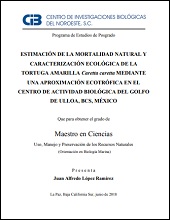Mostrar el registro sencillo del ítem
Estimación de la mortalidad natural y caracterización ecológica de la tortuga amarilla Caretta caretta mediante una aproximación ecotrófica en el centro de actividad biológica del Golfo de Ulloa, BCS, México
| dc.contributor | CESAR AUGUSTO SALINAS ZAVALA | |
| dc.creator | JUAN ALFREDO LOPEZ RAMIREZ | |
| dc.date | 2018-06 | |
| dc.identifier | http://cibnor.repositorioinstitucional.mx/jspui/handle/1001/1307 | |
| dc.identifier.uri | http://dspace.cibnor.mx:8080/handle/123456789/2694 | |
| dc.description | "La tortuga amarilla Caretta caretta, se distribuye en las regiones tropicales alrededor del mundo. En el Océano Pacífico sus playas de anidación se encuentran en el archipiélago japonés, las crías que allí nacen migran 12,000 km aproximadamente, para alimentarse. Algunas de éstas se congregan en las costas que conforman el Golfo de Ulloa, dentro de éste encontramos un Centro de Actividad Biológica. Los BAC´S (por sus siglas en ingles), son regiones oceanográficas que poseen una alta productividad biológica, por lo que son de importancia ecológica y económica dada la cantidad de recursos que se asocian a él. Por otro lado, dentro de esta zona existen comunidades pesqueras con mucho arraigo, lo que le proporciona importancia social ya que la pesca es la principal fuente de ingreso de estas comunidades. En esta área se han presentado varamientos de C. caretta alcanzando sus máximos históricos en 2012 y 2013, sin que se determinaran las causas de estos eventos, aunque se ha propuesto que la interacción de esta especie con la pesca ribereña podría ser la causa de estos, el estudio de otros aspectos ecológicos de la especie como es su mortalidad natural han quedado de lado. Allen (1971) demostró, que la tasa de mortalidad natural M, es aproximada a la relación de producción biomasa (P/B) de la población siempre que la población se encuentre en estado estacionario; bajo este supuesto, la construcción de un modelo ecotrófico Ecopath with Ecosim, con escenarios de simulación de variabilidad ambiental y antropogénica, permitió estimar atributos ecológicos de la especie como su biomasa (0.100 t/km2), eficiencia ecotrófica (0.5), nivel trófico (3.37) y producción/biomasa (1.023 biomasa/año), por otro lado, los escenarios comprobaron la hipótesis del trabajo al mostrar que, la temperatura tiene mayor influencia sobre el organismo en comparación con la pesca incidental resultante del esfuerzo pesquero (f) de la zona, al mostrar valores más altos de M en temperaturas frías, incluso en el escenario con ausencia de f (1.11). El modelo también permitió estimar con bastante certidumbre los valores del sistema corroborando así su capacidad productora con una producción primaria total de 1405.415 t/km2/año..." | |
| dc.description | "Loggerhead turtle Caretta caretta, distributed a long all tropical regions around the world. In the pacific ocean its nesting beaches are foun in japan, the offspring born there migrate 12,000 km approximately to feed. Some of these turtles congregate on the coast that make up the Gulf of Ulloa, within which find a Biological Active Center (BAC), those are oceanographic regions that got high biological productivity, so those are of ecological and economic importance given the amount of resources associated with it. On the other hand, within this zone there are fishing communities with a lot of roots, which gives it social importance because fishing is the main source of income for these communities. In this area there have been stranding of C. caretta, reaching its historical maximun in 2012 and 2013, without determining the causes of these events, although it has been proposed that the interaction of this species with riparian fishing could be the cause of these, nevertheless, the study of other ecological aspects of the species such as its natural mortality have been left aside. Allen (1971) showed that the natural mortality rate M is close to the biomass production ratio (P/B) of the population, provided that the population is in a steady state; under this assumption, the construction of an ecotrophic model Ecopath with Ecosim with simulations scenarios of enviromental and anthropogenic variability, allowed estimating ecological attributes of the species such as its biomass (0.100 t/km2), ecotrophic efficiency (0.5), trophic level (3.37) and production/biomass (1.023 biomass/year), on the other hand, the scenarios proved the hypothesis of the work by showing that the temperature got a greater influence on the organism in comparison with the incidental catch resulting from the fishing effort (f) of the zone, by showing higher values of M in cold temperatures, even in the scenario with absence of f (1.11). The model also allowed to estimate with certainty the values of the system corroborating its production capacity with a total primary production of 1405.415 t/km2/year..." | |
| dc.format | application/pdf | |
| dc.language | spa | |
| dc.publisher | Centro de Investigaciones Biológicas del Noroeste, S.C. | |
| dc.rights | info:eu-repo/semantics/openAccess | |
| dc.rights | http://creativecommons.org/licenses/by-nc-nd/4.0 | |
| dc.subject | info:eu-repo/classification/AUTOR/Caretta caretta, Mortalidad natural, Ecopath with Ecosim, Centro de Actividad Biológica, Golfo de Ulloa | |
| dc.subject | info:eu-repo/classification/AUTOR/Natural mortality, ecopath with ecosim, biological active center, Gulf of Ulloa | |
| dc.subject | info:eu-repo/classification/cti/2 | |
| dc.subject | info:eu-repo/classification/cti/24 | |
| dc.subject | info:eu-repo/classification/cti/2401 | |
| dc.subject | info:eu-repo/classification/cti/240106 | |
| dc.subject | info:eu-repo/classification/cti/240106 | |
| dc.title | Estimación de la mortalidad natural y caracterización ecológica de la tortuga amarilla Caretta caretta mediante una aproximación ecotrófica en el centro de actividad biológica del Golfo de Ulloa, BCS, México | |
| dc.type | info:eu-repo/semantics/masterThesis | |
| dc.type | info:eu-repo/semantics/acceptedVersion |


